Apps
Auto Added by WPeMatico
Auto Added by WPeMatico
What if, instead of sitting on your phone on the sofa ordering stuff from Amazon, you could buy the same things locally from local stores that ultimately enliven and enrich your local neighborhood? What if by doing that, you wouldn’t be walking through deserted main streets, past boarded-up shops, dark alleys and graffiti? What if someone created a marketplace for independent businesses, local events and experiences that kept the money in the local economy rather than being siphoned off into global giants who don’t care about human-scale communities?
That’s the idea behind Pixie, a new take on the “shop-local app” startup model which, although it’s been tried before, has never quite managed to take off. Perhaps Pixie will have more luck?
Here’s how it works: The Pixie app connects people to independent businesses through a curated marketplace, incentivizing them to pay through the app and get rewarded for being loyal customers. Integrated into the app is Pixie Pay, a bespoke payment solution which keeps money in local hands.
The startup has a fascinating background. Whilst serving in the British Special Forces, Pixie’s founder Greg Barden understood that his mission was also to ‘win hearts and minds’ with the local population. Whether by buying bread from the local baker in a village in Afghanistan, or coffee from the market in Baghdad, he and his soldiers could tear down even the most hostile barriers.
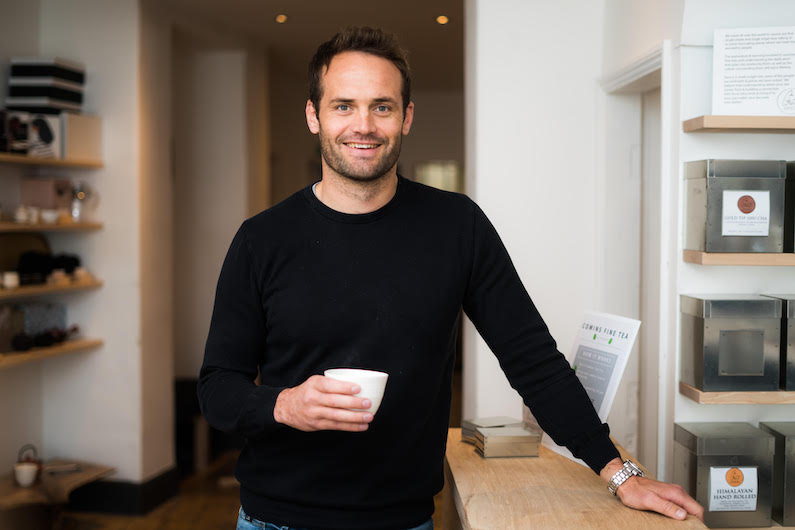
He also realized that when more money stayed inside these the local economies rather than being sucked away by organized crime or large scale, globalized businesses, the local economy might flourish and the risk of the societies there becoming yet again destabilized could potentially diminish.
“Whether it was stalls in the bazaars of Baghdad or small boutiques on Bath high-street, I realized independent shop owners are linchpins in their community. They add variety to the mundane and nurture community spirit. Even local guardians need protecting sometimes, which is why we created Pixie.”
The threat to independent stores from globalization and digitization isn’t just happening in Afghanistan. Across the western world, ‘Main Street’ stores are closing at a prodigious rate. In the UK over 1,500 local stores closed in 2018. (And that was BEFORE Brexit…)
Pixie has stress-tested its idea in mid-sized town in the UK, including Bath, Frome and Sherbourne, completing transactions across 250 businesses, ranging from cafes to fashion boutiques, and spinning up 5,000 app users. It’s now going on the fund-raising trail, aiming to raise £500,000 in funding through its ‘Equity for Explorers’ campaign on Crowdcube a UK-based crowd-equity platform. The total addressable market for independent business in the UK is estimated to be £31.5bn in gross transactional value.
Barden — who last year spoke about his startup life at the launch of the military tech non-profit TechVets — says: “There might be thousands of independent businesses across the UK, but at the rate the high-street is disappearing they are severely under threat. Pixie isn’t here to turn people away from the bigger players on the high-street, but create opportunities for enriching discovery. Needless to say, in a world with increasing nationalism, Brexit, Trump and — dare I say it — Amazon, we feel Pixie has a huge part to play in countering the worst aspects of globalization.”
Pixie’s revenue comes from transaction fees taken when people use its ‘Pixie Pay’ payment mechanism. The payment system is designed to bypass Visa/Mastercard at the point of sale, whilst the loyalty scheme unites independent businesses under one umbrella, so the users can earn and spend their loyalty points (as money) across the entire Pixie community. If a store using Pixie is in Australia, a person from Bath could also use their points there. This keeps the money circulating inside local, independent stores, wherever they are on the planet.
Pixie distributes its own payment terminal that sits next to whatever the business has in place to take normal card payments (iZettle etc). The cards are contactless but don’t utilise visa MasterCard. It’s literally their own e-money system. Think PayPal where users can either add money to their balance by debit card or bank and/or link a debit card to Pixie if they don’t have a balance.
Obviously this also creates it an alternative to competitors like iZettle, Square, SumUp and WorldPay, but this time specifically aimed at local independent stores, not huge national and international chains.
The third element of Pixie is its discovery marketplace that gives its community of explorers (users) the ability to discover local businesses across the Pixie footprint of stores.
I’ve seen several startups try and tackle this problem, but it may well be that Pixie, under its charismatic leader, finally has a shot at cracking this idea around local markets.
Powered by WPeMatico
Ten years after the launch of Foursquare at SXSW, the company is laying its technology bare with a futuristic version of its old app that doesn’t require a check-in at all. The godfather of location apps is returning to the launchpad with Hypertrending, but this time it hopes to learn what developers might do with real-time info about where people are and where they aren’t.
Hypertrending uses Foursquare’s Pilgrim technology, which is baked into Foursquare’s apps and offered as a third-party enterprise tool, to show where phones are in real time over the course of SXSW in Austin, Texas.
This information is relayed through dots on a map. The size of those dots is a reflection of the number of devices in that place at a given time. Users can filter the map by All places, Food, Nightlife and Fun (events and parties).
Hypertrending also has a Top 100 list that is updated in real time to show which places are super popular, with arrows to show whether a place is trending up or down.
Before you throw up your hands in outrage, the information on Hypertrending is aggregated and anonymized (just like it is within Pilgrim), and there are no trails showing the phone’s route from one place to another. Dots only appear on the map when the phone arrives at a destination.
Hypertrending was cooked up in Foursquare’s skunkworks division, Foursquare Labs, led by the company’s co-founder Dennis Crowley .
The feature is only available during SXSW and in the Austin area, and thus far Foursquare has no plans to launch this publicly. So… what’s the deal?
First and foremost, Hypertrending is about showing off the technology. In many ways, Hypertrending isn’t new at all, in that it runs off the Pilgrim technology that has powered Foursquare since around 2014.
Pilgrim is the tech that recognizes you’ve just sat down at a restaurant and offers up a tip about the menu on Foursquare City Guide, and it’s the same tech that notices you’ve just touched down in a new city and makes some recommendations on places to go. In Swarm, it’s the tech that offers up a list of all the places you’ve been in case you want to retroactively check in to them.
That sounds rather simple, but a combination of Foursquare’s 10 years’ worth of location data and Pilgrim’s hyper-precision is unparalleled when it comes to accuracy, according to Crowley.
Whereas other location tech might not understand the difference between you being in the cafe on the first floor or the salon on the second floor, or the bar that shares a wall with both, Pilgrim does.
This is what led Foursquare to build out the Pilgrim SDK, which now sees more than 100 million user-confirmed visits per month. Apps that use the Pilgrim SDK offer users the ability to opt-in to Foursquare’s always-on location tracking for its mobile app panel in the U.S., which has grown to 10 million devices.
These 10 million phones provide the data that powers Hypertrending.
Now, the data itself might not be new, per se. But Foursquare has never visualized the information quite like this, even for enterprise customers.
Whereas customers of the Foursquare Place Insights, Pinpoint and Attribution get snapshots into their own respective audiences, Hypertrending represents on a large scale just what Foursquare’s tech is capable of in not only knowing where people are, but where people aren’t.

This brings us back to SXSW, which happens to be the place where Foursquare first launched back in 2009.
“This week has felt a little nostalgic as we try to get this thing ready to go,” said Crowley. “It’s not that dissimilar to when we went to SXSW in 2009 and showed off Foursquare 1.0. There is this curious uncertainty and my whole thing is to get a sense of what people think of it.”
Crowley recalled his first trip to SXSW with co-founder Naveen Selvadurai. They couldn’t afford an actual pass to the show so they just went from party to party showing people the app and hearing what they thought. Crowley said that he doesn’t expect Hypertrending to be some huge consumer app.
“I want to show off what we can do with the technology and the data and hopefully inspire developers to do interesting stuff with this raw visualization of where phones are at,” said Crowley. “What would you do if you had access to this? Would you make something cool and fun or make something obnoxious and creepy?”
Beyond the common tie of SXSW, Hypertrending brings Foursquare’s story full circle in the fact that it’s potentially the most poignant example of what Crowley always wanted Foursquare to be. Location is one of the most powerful pieces of information about an individual. One’s physical location is, in many ways, the most purely truthful piece of information about them in a sea of digital clicks and scroll-bys.
If this data could be harnessed properly, without any work on the side of the consumer, what possibilities might open up?
“We’ve long talked about making ‘a check-in button you never had to press,’ ” said Crowley in the blog post. “Hypertrending is part of that vision realized, spread across multiple apps and services.”
Crowley also admits in the blog post that Hypertrending walks a fine line between creepy and cool, which is another reason for the ephemeral nature of the feature. It’s also the exact reason he wants to open it up to everyone.
From the blog post:
After 10 years, it’s clear that we (Foursquare!) are going to play a role in influencing how contextual-aware technologies shape the future – whether that’s apps that react to where you are and where you’ve been, smarter virtual assistants (e.g Alexa, Siri, Marsbot) that understand how you move through cities, or AR objects that need to appear at just the right time in just the right spot. We want to build a version of the future that we’re proud of, and we want your input as we get to work building it.
And…
We made Hypertrending to show people how Foursquare’s panel works in terms of what it can do (and what it will not do), as well as to show people how we as a company think about navigating this space. We feel the general trend with internet and technology companies these days has been to keep giving users a more and more personalized (albeit opaquely personalized) view of the world, while the companies that create these feeds keep the broad “God View” to themselves. Hypertrending is one example of how we can take Foursquare’s aggregate view of the world and make it available to the users who make it what it is. This is what we mean when we talk about “transparency” – we want to be honest, in public, about what our technology can do, how it works, and the specific design decisions we made in creating it.
We asked Crowley what would happen if brands and marketers loved the idea of Hypertrending, but general consumers were freaked out?
“This is an easy question,” said Crowley. “If this freaks people out, we don’t build stuff with it. We’re not ready for it yet. But I’d go back to the drawing board and ask ‘What do we learn from people that are freaked out about it that would help us communicate to them,’ or ‘what are the changes we could make to this that would make people comfortable,’ or ‘what are the things we could build that would illustrate the value of this that this view didn’t communicate?’ ”
As mentioned above, Hypertrending is only available during the SXSW conference in the Austin area. Users can access Hypertrending through both the Foursquare City Guide app and Swarm by simply shaking their phone.
Powered by WPeMatico
Serial Box, a startup bringing back the tradition of serialized fiction, has raised $4.5 million in seed funding.
The company actually disclosed the funding last week when announcing a partnership to produce stories about Marvel characters, but it’s sharing more details about the round — namely, the fact that it was led by Boat Rocker Media, with participation from Forerunner Ventures, 2929 Entertainment co-founder Todd Wagner and Japanese business intelligence and media firm Uzabase.
“We carefully chose trusted partners for this round of investment,” said co-founder and CEO Molly Barton in a statement. “They see the big opportunity that we do to retool reading for the smartphone age, to take the best elements of traditional book publishing and innovate with influences from the audio, podcast, gaming and TV industries.”
Serial Box publishes stories in text and audio format, broken up into weekly episodes. The first episode of each story is free — then if you’re hooked, you can pay $1.99 for additional episodes or sign up for a season pass.
The idea of making readers and listeners wait for the next chapter of the story may seem strange. Hasn’t Netflix trained us to want to binge the full season, as soon as possible? Maybe, but anyone who has watched “Game of Thrones” week-to-week knows that there’s still immense pleasure in waiting for smaller chunks of the larger story.
Behind the scenes, the company is borrowing from the TV production model, with a showrunner leading each writing time creating the stories. Serial Box writers include popular YA/science fiction/fantasy authors Gwenda Bond, Yoon Ha Lee, Max Gladstone and Becky Chambers. And, as mentioned, the company will also be publishing stories based on Marvel characters, starting with Thor.
The company says it will launch its Android app next week, with plans for more product upgrades and content partnerships in the coming months.
Powered by WPeMatico
The next phase of social media is about hanging out together while apart. Rather than performing on a live stream or engaging with a video chat, Instagram may allow you to chill and watch videos together with a friend. Facebook already has Watch Party for group co-viewing, and in November we broke the news that Facebook Messenger’s code contains an unreleased “Watch Videos Together” feature. Now Instagram’s code reveals a “co-watch content” feature hidden inside Instagram Direct Messaging.
It’s unclear what users might be able to watch simultaneously, but the feature could give IGTV a much-needed boost, or just let you laugh and cringe at Instagram feed videos and Stories. But either way, co-viewing could make you see more ads, drive more attention to creators that will win Instagram their favor or just make you rack up time spent on the app without forcing you to create anything.
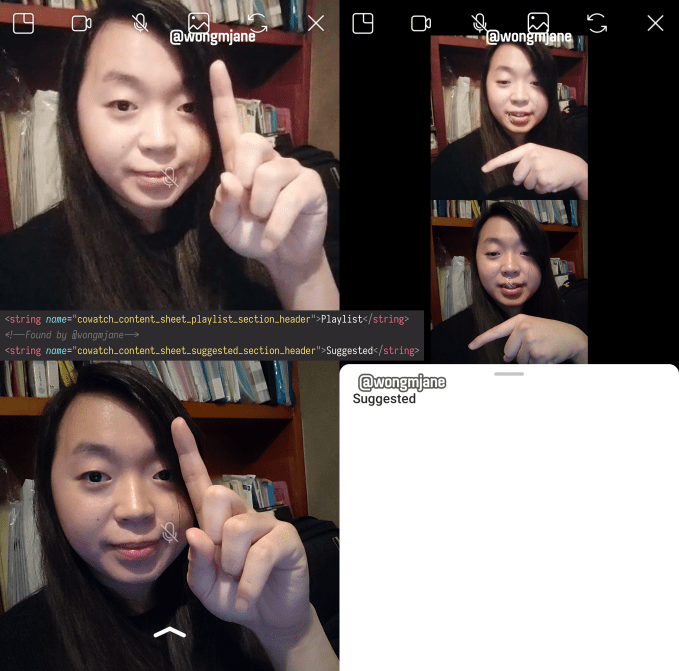
The Instagram co-watch code was discovered by TechCrunch’s favorite tipster and reverse-engineering specialist Jane Manchun Wong, who previously spotted the Messenger Watch Together code. Her past findings include Instagram’s video calling, music soundtracks and Time Well Spent dashboard, months before they were officially released. The code mentions that you can “cowatch content” that comes from a “Playlist” similar to the queues of videos Facebook Watch Party admins can tee up. Users could also check out “Suggested” videos from Instagram, which would give it a new way to promote creators or spawn a zeitgeist moment around a video. It’s not certain whether users will be able to appear picture-in-picture while watching so friends can see their reactions, but that would surely be more fun.
Instagram declined to comment on the findings, which is typical of the company when a feature has been prototyped internally but hasn’t begun externally testing with users. At this stage, products can still get scrapped or take many months or even more than a year to launch. But given Facebook’s philosophical intention to demote mindless viewing and promote active conversation around videos, Instagram co-watching is a sensible direction.
Facebook launched Watch Party to this end back in July, and by November, 12 million had been started from Groups and they generated 8X more comments than non-synced or Live videos. That proves co-watching can make video feel less isolating. That’s important as startups like Houseparty group video chatrooms and Squad screenshare messaging try to nip at Insta’s heels.
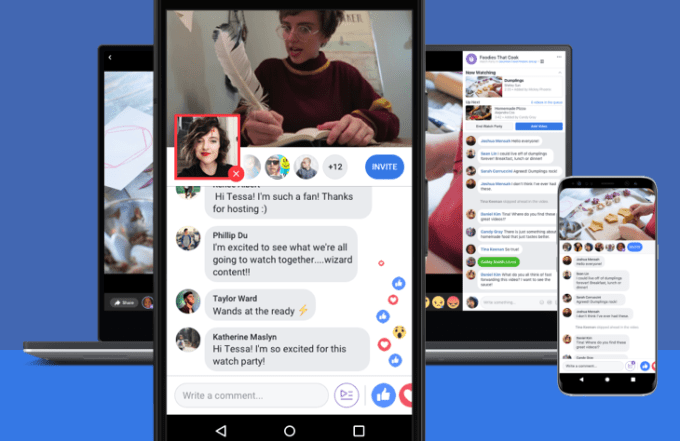
It’s also another sign that following the departure of the Instagram founders, Facebook has been standardizing features across its apps, eroding their distinct identities. Mark Zuckerberg plans to unify the backend of Facebook Messenger, WhatsApp, and Instagram to allow cross-app messaging. But Instagram has always been Facebook’s content-first app, so while Watch Party might have been built for Facebook Groups, Instagram could be where it hits its stride.
Speaking of the Instagram founders Kevin Systrom and Mike Krieger, this article’s author Josh Constine will be interviewing them on Monday 3/11 at SXSW. Come see them at 2 pm in the Austin Convention Center’s Ballroom D to hear about their thoughts on the creator economy, why they left Facebook and what they’ll do next. Check out the rest of TechCrunch’s SXSW panels here, and RSVP for our party on Sunday.
Powered by WPeMatico
When we first wrote about Hooch, it offered a fun, straightforward deal — for $9.99 per month, you could claim one free drink per day from participating bars and restaurants.
Since then, the company launched Hooch Black, a pricier subscription that includes perks like hotel discounts and concierge service. But even then, co-founder and CEO Lin Dai was hinting at plans to use blockchain technology to create what he called “a decentralized model for consumer rewards.”
Now Hooch is delivering on what Dai promised, with a relaunched app that rewards users for their purchases.
“We were super excited about the feedback and response [to Hooch Black] that we saw from our members,” Dai said. “What we decided to do is just completely update the app with rewards for consumers across four different categories — travel, dining, entertainment and e-commerce.”
He noted that while most loyalty programs reward you for using a specific card or for shopping with a specific company, Hooch has partnered with more than 250,000 merchants (including Marriott hotels, TAO restaurants, Starbucks, Uber and Amazon). The company can actually scan the purchases made on any linked debit or credit card, and you’ll be rewarded whenever you spend money with those partners.
The rewards take the form of what Hooch is calling TAP rewards dollars — the exact reward will vary depending on the merchant, but the company says it could be as high as 10 percent of your spending.

Lin Dai, CEO of Hooch
Dai said TAP dollars are actually a stablecoin pegged to the U.S. dollar, but he emphasized that you don’t need to understand the backend to use the rewards. For most users, TAP dollars will simply be a digital currency they can redeem for hotel bookings, restaurants credits and gift cards.
“Security is our top concern,” Dai added. The idea is to access your transaction history to verify your purchases (Hooch makes money by driving purchases for merchants), but without storing or sharing identifying information. “When we capture the consumer purchase information, we actually don’t capture any of their names or credit card numbers … We don’t store any identity.”
The program also comes with a big perk for enlisting your friends. There is an upfront reward of five TAP dollars, but the real selling point is the fact that you’ll get 20 percent of their rewards — not just on their initial purchases, but for the entire time they use the app.
If you like the Hooch Black plan, you’ll still be able to sign up and pay for it. But the company’s emphasis has shifted to the broader rewards program, which you can join for free.
Powered by WPeMatico
On feed-based “broader social networks, where people can accumulate friends or followers until the services feel more public . . . it feels more like a town square than a more intimate space like a living room” Facebook CEO Mark Zuckerberg explained in a blog post today. With messaging, groups, and ephemeral stories as the fastest growing social features, Zuckerberg laid out why he’s rethinking Facebook as a private living room where people can be comfortable being themselves without fear of hackers, government spying, and embarrassment from old content — all without encryption allowing bad actors to hide their crimes.
Perhaps this will just be more lip service in a time of PR crisis for Facebook. But with the business imperative fueled by social networking’s shift away from permanent feed broadcasting, Facebook can espouse the philosophy of privacy while in reality servicing its shareholders and bottom line. It’s this alignment that actually spurs product change. We saw Facebook’s agility with last year’s realization that a misinformation- and hate-plagued platform wouldn’t survive long-term so it had to triple its security and moderation staff. And in 2017, recognizing the threat of Stories, it implemented them across its apps. Now Facebook might finally see the dollar signs within privacy.

The New York Times’ Mike Isaac recently reported that Facebook planned to unify its Facebook, WhatsApp, and Instagram messaging infrastructure to allow cross-app messaging and end-to-end encryption. And Zuckerberg discussed this and the value of ephemerality on the recent earnings call. But now Zuckerberg has roadmapped a clearer slate of changes and policies to turn Facebook into a living room:
-Facebook will let users opt in to the ability to send or receive messages across Facebook, WhatsApp, and Instagram
-Facebook wants to expand that interoperability to SMS on Android
-Zuckerberg wants to make ephemerality automatic on messaging threads, so chats disappear by default after a month or year, with users able to control that or put timers on individual messages.
-Facebook plans to limit how long it retains metadata on messages once it’s no longer needed for spam or safety protections
-Facebook will extend end-to-end encryption across its messaging apps but use metadata and other non-content signals to weed out criminals using privacy to hide their misdeeds.
-Facebook won’t store data in countries with a bad track record of privacy abuse such as Russia, even if that means having to shut down or postpone operations in a country
You can read the full blog post from Zuckerberg below:
Posted by Mark Zuckerberg on Wednesday, March 6, 2019
A Privacy-Focused Vision for Social Networking
My focus for the last couple of years has been understanding and addressing the biggest challenges facing Facebook. This means taking positions on important issues concerning the future of the internet. In this note, I’ll outline our vision and principles around building a privacy-focused messaging and social networking platform. There’s a lot to do here, and we’re committed to working openly and consulting with experts across society as we develop this.
—
Over the last 15 years, Facebook and Instagram have helped people connect with friends, communities, and interests in the digital equivalent of a town square. But people increasingly also want to connect privately in the digital equivalent of the living room. As I think about the future of the internet, I believe a privacy-focused communications platform will become even more important than today’s open platforms. Privacy gives people the freedom to be themselves and connect more naturally, which is why we build social networks.
Today we already see that private messaging, ephemeral stories, and small groups are by far the fastest growing areas of online communication. There are a number of reasons for this. Many people prefer the intimacy of communicating one-on-one or with just a few friends. People are more cautious of having a permanent record of what they’ve shared. And we all expect to be able to do things like payments privately and securely.
Public social networks will continue to be very important in people’s lives — for connecting with everyone you know, discovering new people, ideas and content, and giving people a voice more broadly. People find these valuable every day, and there are still a lot of useful services to build on top of them. But now, with all the ways people also want to interact privately, there’s also an opportunity to build a simpler platform that’s focused on privacy first.
I understand that many people don’t think Facebook can or would even want to build this kind of privacy-focused platform — because frankly we don’t currently have a strong reputation for building privacy protective services, and we’ve historically focused on tools for more open sharing. But we’ve repeatedly shown that we can evolve to build the services that people really want, including in private messaging and stories.
I believe the future of communication will increasingly shift to private, encrypted services where people can be confident what they say to each other stays secure and their messages and content won’t stick around forever. This is the future I hope we will help bring about.
We plan to build this the way we’ve developed WhatsApp: focus on the most fundamental and private use case — messaging — make it as secure as possible, and then build more ways for people to interact on top of that, including calls, video chats, groups, stories, businesses, payments, commerce, and ultimately a platform for many other kinds of private services.
This privacy-focused platform will be built around several principles:
Private interactions. People should have simple, intimate places where they have clear control over who can communicate with them and confidence that no one else can access what they share.
Encryption. People’s private communications should be secure. End-to-end encryption prevents anyone — including us — from seeing what people share on our services.
Permanence. People should be comfortable being themselves, and should not have to worry about what they share coming back to hurt them later. So we won’t keep messages or stories around for longer than necessary to deliver the service or longer than people want it.
Safety. People should expect that we will do everything we can to keep them safe on our services within the limits of what’s possible in an encrypted service.
Interoperability. People should be able to use any of our apps to reach their friends, and they should be able to communicate across networks easily and securely.
Secure data storage. People should expect that we won’t store sensitive data in countries with weak records on human rights like privacy and freedom of expression in order to protect data from being improperly accessed.
Over the next few years, we plan to rebuild more of our services around these ideas. The decisions we’ll face along the way will mean taking positions on important issues concerning the future of the internet. We understand there are a lot of tradeoffs to get right, and we’re committed to consulting with experts and discussing the best way forward. This will take some time, but we’re not going to develop this major change in our direction behind closed doors. We’re going to do this as openly and collaboratively as we can because many of these issues affect different parts of society.
Private Interactions as a Foundation
For a service to feel private, there must never be any doubt about who you are communicating with. We’ve worked hard to build privacy into all our products, including those for public sharing. But one great property of messaging services is that even as your contacts list grows, your individual threads and groups remain private. As your friends evolve over time, messaging services evolve gracefully and remain intimate.
This is different from broader social networks, where people can accumulate friends or followers until the services feel more public. This is well-suited to many important uses — telling all your friends about something, using your voice on important topics, finding communities of people with similar interests, following creators and media, buying and selling things, organizing fundraisers, growing businesses, or many other things that benefit from having everyone you know in one place. Still, when you see all these experiences together, it feels more like a town square than a more intimate space like a living room.
There is an opportunity to build a platform that focuses on all of the ways people want to interact privately. This sense of privacy and intimacy is not just about technical features — it is designed deeply into the feel of the service overall. In WhatsApp, for example, our team is obsessed with creating an intimate environment in every aspect of the product. Even where we’ve built features that allow for broader sharing, it’s still a less public experience. When the team built groups, they put in a size limit to make sure every interaction felt private. When we shipped stories on WhatsApp, we limited public content because we worried it might erode the feeling of privacy to see lots of public content — even if it didn’t actually change who you’re sharing with.
In a few years, I expect future versions of Messenger and WhatsApp to become the main ways people communicate on the Facebook network. We’re focused on making both of these apps faster, simpler, more private and more secure, including with end-to-end encryption. We then plan to add more ways to interact privately with your friends, groups, and businesses. If this evolution is successful, interacting with your friends and family across the Facebook network will become a fundamentally more private experience.
Encryption and Safety
People expect their private communications to be secure and to only be seen by the people they’ve sent them to — not hackers, criminals, over-reaching governments, or even the people operating the services they’re using.
There is a growing awareness that the more entities that have access to your data, the more vulnerabilities there are for someone to misuse it or for a cyber attack to expose it. There is also a growing concern among some that technology may be centralizing power in the hands of governments and companies like ours. And some people worry that our services could access their messages and use them for advertising or in other ways they don’t expect.
End-to-end encryption is an important tool in developing a privacy-focused social network. Encryption is decentralizing — it limits services like ours from seeing the content flowing through them and makes it much harder for anyone else to access your information. This is why encryption is an increasingly important part of our online lives, from banking to healthcare services. It’s also why we built end-to-end encryption into WhatsApp after we acquired it.
In the last year, I’ve spoken with dissidents who’ve told me encryption is the reason they are free, or even alive. Governments often make unlawful demands for data, and while we push back and fight these requests in court, there’s always a risk we’ll lose a case — and if the information isn’t encrypted we’d either have to turn over the data or risk our employees being arrested if we failed to comply. This may seem extreme, but we’ve had a case where one of our employees was actually jailed for not providing access to someone’s private information even though we couldn’t access it since it was encrypted.
At the same time, there are real safety concerns to address before we can implement end-to-end encryption across all of our messaging services. Encryption is a powerful tool for privacy, but that includes the privacy of people doing bad things. When billions of people use a service to connect, some of them are going to misuse it for truly terrible things like child exploitation, terrorism, and extortion. We have a responsibility to work with law enforcement and to help prevent these wherever we can. We are working to improve our ability to identify and stop bad actors across our apps by detecting patterns of activity or through other means, even when we can’t see the content of the messages, and we will continue to invest in this work. But we face an inherent tradeoff because we will never find all of the potential harm we do today when our security systems can see the messages themselves.
Finding the right ways to protect both privacy and safety is something societies have historically grappled with. There are still many open questions here and we’ll consult with safety experts, law enforcement and governments on the best ways to implement safety measures. We’ll also need to work together with other platforms to make sure that as an industry we get this right. The more we can create a common approach, the better.
On balance, I believe working towards implementing end-to-end encryption for all private communications is the right thing to do. Messages and calls are some of the most sensitive private conversations people have, and in a world of increasing cyber security threats and heavy-handed government intervention in many countries, people want us to take the extra step to secure their most private data. That seems right to me, as long as we take the time to build the appropriate safety systems that stop bad actors as much as we possibly can within the limits of an encrypted service. We’ve started working on these safety systems building on the work we’ve done in WhatsApp, and we’ll discuss them with experts through 2019 and beyond before fully implementing end-to-end encryption. As we learn more from those experts, we’ll finalize how to roll out these systems.
Reducing Permanence
We increasingly believe it’s important to keep information around for shorter periods of time. People want to know that what they share won’t come back to hurt them later, and reducing the length of time their information is stored and accessible will help.
One challenge in building social tools is the “permanence problem”. As we build up large collections of messages and photos over time, they can become a liability as well as an asset. For example, many people who have been on Facebook for a long time have photos from when they were younger that could be embarrassing. But people also really love keeping a record of their lives. And if all posts on Facebook and Instagram disappeared, people would lose access to a lot of valuable knowledge and experiences others have shared.
I believe there’s an opportunity to set a new standard for private communication platforms — where content automatically expires or is archived over time. Stories already expire after 24 hours unless you archive them, and that gives people the comfort to share more naturally. This philosophy could be extended to all private content.
For example, messages could be deleted after a month or a year by default. This would reduce the risk of your messages resurfacing and embarrassing you later. Of course you’d have the ability to change the timeframe or turn off auto-deletion for your threads if you wanted. And we could also provide an option for you to set individual messages to expire after a few seconds or minutes if you wanted.
It also makes sense to limit the amount of time we store messaging metadata. We use this data to run our spam and safety systems, but we don’t always need to keep it around for a long time. An important part of the solution is to collect less personal data in the first place, which is the way WhatsApp was built from the outset.
Interoperability
People want to be able to choose which service they use to communicate with people. However, today if you want to message people on Facebook you have to use Messenger, on Instagram you have to use Direct, and on WhatsApp you have to use WhatsApp. We want to give people a choice so they can reach their friends across these networks from whichever app they prefer.
We plan to start by making it possible for you to send messages to your contacts using any of our services, and then to extend that interoperability to SMS too. Of course, this would be opt-in and you will be able to keep your accounts separate if you’d like.
There are privacy and security advantages to interoperability. For example, many people use Messenger on Android to send and receive SMS texts. Those texts can’t be end-to-end encrypted because the SMS protocol is not encrypted. With the ability to message across our services, however, you’d be able to send an encrypted message to someone’s phone number in WhatsApp from Messenger.
This could also improve convenience in many experiences where people use Facebook or Instagram as their social network and WhatsApp as their preferred messaging service. For example, lots of people selling items on Marketplace list their phone number so people can message them about buying it. That’s not ideal, because you’re giving strangers your phone number. With interoperability, you’d be able to use WhatsApp to receive messages sent to your Facebook account without sharing your phone number — and the buyer wouldn’t have to worry about whether you prefer to be messaged on one network or the other.
You can imagine many simple experiences — a person discovers a business on Instagram and easily transitions to their preferred messaging app for secure payments and customer support; another person wants to catch up with a friend and can send them a message that goes to their preferred app without having to think about where that person prefers to be reached; or you simply post a story from your day across both Facebook and Instagram and can get all the replies from your friends in one place.
You can already send and receive SMS texts through Messenger on Android today, and we’d like to extend this further in the future, perhaps including the new telecom RCS standard. However, there are several issues we’ll need to work through before this will be possible. First, Apple doesn’t allow apps to interoperate with SMS on their devices, so we’d only be able to do this on Android. Second, we’d need to make sure interoperability doesn’t compromise the expectation of encryption that people already have using WhatsApp. Finally, it would create safety and spam vulnerabilities in an encrypted system to let people send messages from unknown apps where our safety and security systems couldn’t see the patterns of activity.
These are significant challenges and there are many questions here that require further consultation and discussion. But if we can implement this, we can give people more choice to use their preferred service to securely reach the people they want.
Secure Data Storage
People want to know their data is stored securely in places they trust. Looking at the future of the internet and privacy, I believe one of the most important decisions we’ll make is where we’ll build data centers and store people’s sensitive data.
There’s an important difference between providing a service in a country and storing people’s data there. As we build our infrastructure around the world, we’ve chosen not to build data centers in countries that have a track record of violating human rights like privacy or freedom of expression. If we build data centers and store sensitive data in these countries, rather than just caching non-sensitive data, it could make it easier for those governments to take people’s information.
Upholding this principle may mean that our services will get blocked in some countries, or that we won’t be able to enter others anytime soon. That’s a tradeoff we’re willing to make. We do not believe storing people’s data in some countries is a secure enough foundation to build such important internet infrastructure on.
Of course, the best way to protect the most sensitive data is not to store it at all, which is why WhatsApp doesn’t store any encryption keys and we plan to do the same with our other services going forward.
But storing data in more countries also establishes a precedent that emboldens other governments to seek greater access to their citizen’s data and therefore weakens privacy and security protections for people around the world. I think it’s important for the future of the internet and privacy that our industry continues to hold firm against storing people’s data in places where it won’t be secure.
Next Steps
Over the next year and beyond, there are a lot more details and trade-offs to work through related to each of these principles. A lot of this work is in the early stages, and we are committed to consulting with experts, advocates, industry partners, and governments — including law enforcement and regulators — around the world to get these decisions right.
At the same time, working through these principles is only the first step in building out a privacy-focused social platform. Beyond that, significant thought needs to go into all of the services we build on top of that foundation — from how people do payments and financial transactions, to the role of businesses and advertising, to how we can offer a platform for other private services.
But these initial questions are critical to get right. If we do this well, we can create platforms for private sharing that could be even more important to people than the platforms we’ve already built to help people share and connect more openly.
Doing this means taking positions on some of the most important issues facing the future of the internet. As a society, we have an opportunity to set out where we stand, to decide how we value private communications, and who gets to decide how long and where data should be stored.
I believe we should be working towards a world where people can speak privately and live freely knowing that their information will only be seen by who they want to see it and won’t all stick around forever. If we can help move the world in this direction, I will be proud of the difference we’ve made.
Powered by WPeMatico
Blueground, the startup providing turnkey flexible rental apartments, has raised $20 million in a round led by Athens-based VentureFriends, with participation from Endeavor Catalyst, Dubai’s Jabbar Internet Group and serial entrepreneur Kevin Ryan. Ryan — who helped found MongoDB, Gilt Groupe, Zola and others — will also join Blueground’s board of directors.
It’s no secret that remote work and frequent business travel are becoming more and more commonplace. As a result, a growing number of people are shying away from lengthy rental or lease commitments and are instead turning to companies like Blueground for more flexible short-term solutions.
Blueground is trying to be the go-to option for individuals moving or traveling to a city for as little as a month, or any duration longer. Similar to flexible office space providers, Blueground partners with major property owners to sign long-term leases for units it then furnishes and rents out with more flexible terms.
Users can rent listings for anywhere between one month to five years, and rates are set on a monthly basis, which can often lead to more favorable prices over medium-to-long-term stays relative to the short-term pricing structures commonly used by hospitality companies.
CEO Alex Chatzieleftheriou is intimately familiar with the value flexible leasing can unlock. Before founding Blueground, Chatzieleftheriou worked as a consultant for McKinsey, where he was frequently sent off to projects in far-off cities for months at a time — living in 15 cities over just seven years.
However, no matter how much time Alex logged in hotels, he constantly felt the frustration and mental strain of not having a stable personal living arrangement.
“I spent so much time in hotels but they never really resembled a home. They didn’t have enough space or enough privacy,” Chatzieleftheriou told TechCrunch. “But renting an apartment can be a huge pain in these cities. They can be hard to find, they usually have a minimum rental term of a year or more, and you usually have to deal with filling out paperwork and buying furniture.”
Knowing there were thousands of people at his company alone dealing with the same frustrations, Alex launched what would become Blueground, beginning with a handful of apartments in his home city of Athens, Greece.
Chatzieleftheriou and his team structured the platform to make the rental process as seamless as possible for the needs of flexible renters like himself. Through a quick plug-and-play checkout flow — more similar to the booking process for a hotel or Airbnb — renters can lock down an apartment without having to deal with the painful, costly and time-consuming traditional rental process. Tenants are also able to switch to any other Blueground listing during their rental period if their preferences change or if they want to explore different locations during their stay.
Every Blueground listing also comes completely furnished by the company’s design team, so renters don’t have to deal with buying, transporting — and eventually selling — furniture. And each apartment comes outfitted with digital and connected infrastructure so that tenants can monitor their apartment and arrange maintenance, housekeeping and other services directly through Blueground’s mobile app.
The value proposition is also fairly straightforward for the landlords Blueground partners with, as they avoid costs related to marketing and coordinating with fragmented brokers to fill open units, while also benefiting from steady rental payments, tenant vetting and free property management.
The offering certainly seems to be compelling for renters — while Chatzieleftheriou initially focused on serving business travelers and those moving for work, he quickly realized the market for flexible leasing was in fact much bigger. Blueground’s sales have tripled over the past three years and after its expansion in the U.S. last year, Blueground now hosts 1,700 listings in 10 cities across three continents.
“The trend of flexible and seamless real estate is bigger and is happening everywhere,” Chatzieleftheriou said. “A lot of people throughout the real estate sector really want this seamless, turnkey, furnished solution.”
To date, Blueground has raised a total of $28 million and plans to use funds from the latest round for additional hiring and to help the company reach its goal of growing its portfolio to 50,000 units over the next five years.
Powered by WPeMatico
In October, Walmart-owned Sam’s Club opened a test store in Dallas where it planned to trial new technology, including mobile checkout, an Amazon Go-like camera system, in-store navigation, electronic shelf labels and more. This morning, the retailer announced it will now begin testing a revamped Scan & Go service as well, which leverages computer vision and machine learning to make mobile scanning easier and faster.
The current Scan & Go system, launched two years ago, requires Sam’s Club shoppers to locate the barcode on the item they’re buying and scan it using the Sam’s Club mobile app. The app allows shoppers to account for items they’re buying as they place them in their shopping cart, then pay in the app instead of standing in line at checkout.

However convenient, the system itself can still be frustrating at times because you’ll need to actually find the barcode on the item — often turning the item over from one side to the other to find the sticker or tag. This process can be difficult for heavier items, and frustrating when the barcoded label or tag has fallen off.
It also can end up taking several seconds to complete — which adds up when you’re filling a cart with groceries during a big stocking-up trip.
The new scanning technology will instead use computer vision and ML (machine learning) to recognize products without scanning the barcode, cutting the time it takes for the app to identify the product in question, the retailer explains.
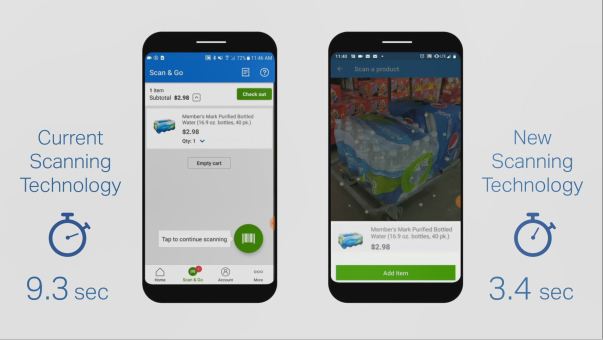
In a video demo, Sam’s Club showed how it might take a typical shopper 9.3 seconds to scan a pack of water using the old system, versus 3.4 seconds using the newer technology.
Of course, the times will vary based on the shopper’s skill, the item being scanned and how well the technology performs, among other factors. A large package of water is a more extreme example, but one that demonstrates well the potential of the system… if it works.
The idea with the newly opened Dallas test store is to put new technology into practice quickly in a real-world environment, to see what performs well and what doesn’t, while also gathering customer feedback. Dallas was chosen as the location for the store because of the tech talent and recruiting potential in the area, and because it’s a short trip from Walmart’s Bentonville, Arkansas headquarters, the company said earlier.
Sam’s Club says it has filed a patent related to the new scanning technology, and will begin testing it this spring at the Dallas area “Sam’s Club Now” store. It will later expand the technology to the tools used by employees, too.
Powered by WPeMatico
Facebook has changed its story after initially trying to downplay how it targeted teens with its Research program that a TechCrunch investigation revealed was paying them gift cards to monitor all their mobile app usage and browser traffic. “Less than 5 percent of the people who chose to participate in this market research program were teens” a Facebook spokesperson told TechCrunch and many other news outlets in a damage control effort 7 hours after we published our report on January 29th. At the time, Facebook claimed that it had removed its Research app from iOS. The next morning we learned that wasn’t true, as Apple had already forcibly blocked the Facebook Research app for violating its Enterprise Certificate program that supposed to reserved for companies distributing internal apps to employees.
It turns out that wasn’t the only time Facebook deceived the public in its response regarding the Research VPN scandal. TechCrunch has obtained Facebook’s unpublished February 21st response to questions about the Research program in a letter from Senator Mark Warner, who wrote to CEO Mark Zuckerberg that “Facebook’s apparent lack of full transparency with users – particularly in the context of ‘research’ efforts – has been a source of frustration for me.”
In the response from Facebook’s VP of US public policy Kevin Martin, the company admits that (emphasis ours) “At the time we ended the Facebook Research App on Apple’s iOS platform, less than 5 percent of the people sharing data with us through this program were teens. Analysis shows that number is about 18 percent when you look at the complete lifetime of the program, and also add people who had become inactive and uninstalled the app.” So 18 percent of research testers were teens. It was only less than 5 percent when Facebook got caught. Given users age 13 to 35 were eligible for Facebook’s Research program, 13 to 18 year olds made of 22 percent of the age range. That means Facebook clearly wasn’t trying to minimize teen involvement, nor were they just a tiny fraction of users.

WASHINGTON, DC – APRIL 10: Facebook co-founder, Chairman and CEO Mark Zuckerberg testifies before a combined Senate Judiciary and Commerce committee hearing in the Hart Senate Office Building on Capitol Hill April 10, 2018 in Washington, DC. (Photo by Chip Somodevilla/Getty Images)
Warner asked Facebook “Do you think any use reasonable understood Facebook was using this data for commercial purposes includingto track competitors?” Facebook response indicates it never told Research users anything about tracking “competitors”, and instead dances around the question. Facebook says the registration process told users the data would help the company “understand how people use mobile apps,” “improve . . . services,” and “introduce new features for millions of people around the world.”
Facebook had also told reporters on January 29th regarding teens’ participation, “All of them with signed parental consent forms.” Yet in its response to Senator Warner, Facebook admitted that “Potential participants were required to confirm that they were over 18 or provide other evidence of parental consent, though the vendors did not require a signed parental consent form for teen users.” In some cases, underage users merely had to check a box to claim they had parental consent, and there was no verification of users’ ages or that their parents actually approved.
So to quickly recap:

Facebook targeted teens with ads on Instagram and Snapchat to join the Research program without revealing its involvement
The contradictions between Facebook’s initial response to reporters and what it told Warner, who has the power to pursue regulation of the the tech giant, shows Facebook willingness to move fast and play loose with the truth when it’s less accountable. It’s no wonder the company never shared the response with TechCrunch or posted a blog post or press release about it.
Facebook’s attempt to minimize the issue in the wake of backlash exemplifies the trend of of the social network’s “reactionary” PR strategy that employees described to BuzzFeed’s Ryan Mac. The company often views its scandals as communications errors rather than actual product screwups or as signals of deep-seeded problems with Facebook’s respect for privacy. Facebook needs to learn to take its lumps, change course, and do better rather than constantly trying to challenge details of negative press about it, especially before it has all the necessary information. Until then, the never-ending news cycle of Facebook’s self-made disasters will continue.
Below is Facebook’s full response to Senator Warner’s inquiry, and following that is Warner’s original letter to Mark Zuckerberg.
Additional reporting by Krystal Hu
Powered by WPeMatico
On the heels of news that TikTok has reached 1 billion downloads, the company today is launching a new initiative designed to help inform users about online safety, TikTok’s various privacy settings and other controls they can use within its app, and more. Instead of dumping this information in an in-app FAQ or help documentation, the company will release a series of video tutorials that are meant to be engaging and fun, in order to better resemble the other content on TikTok itself.
The safety series, called “You’re in Control,” will star TikTok users and make use of popular memes, in-app editing tricks and other effects, just like other TikTok videos do. The videos will appear in the app and be available through the new @tiktoktips account.
The videos will focus on a range of privacy, safety and well-being settings and other safety-related policies. This includes TikTok’s Community Guidelines, how in-app reporting works, plus other settings for protecting your privacy, how to control comments, settings to manage your screen time and more.
They’re not exactly your traditional how-to videos, however.
Instead, the videos showcase what’s often more serious issues — like being overrun with unwanted messages — in a humorous fashion. For example, in the video about configuring your message controls, angry commenters are depicted as shouting passengers on an airplane while the user is depicted by an overwhelmed flight attendant.
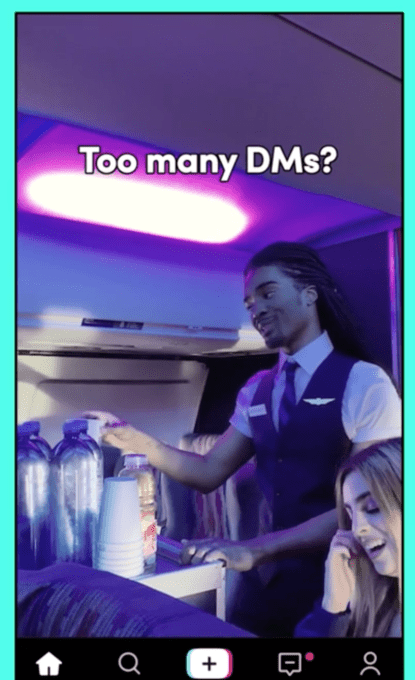
“Too many DMs?,” the video asks. The flight attendant snaps his fingers, which causes most of the passengers to disappear. The scene returns to peace and quiet. It’s a simple enough analogy for TikTok’s younger user base to understand.
This is then followed by a screen recording that shows you how to turn off messaging within the TikTok app’s settings.
Other videos have a similar style.
A barking, growling dog is used to demonstrate Restricted Mode, for instance. A noisy crowd overlooking someone’s shoulder is the intro on the video about using comment controls.
Another video encourages the use of screen time controls, asking “can’t put your phone down?” and shows someone so wrapped up in their phone they aren’t watching where they’re walking.
But the video about the Community Guidelines is maybe the most cringe-y, as it feels a bit like your parents reminding you to “play nice.” However, it still manages to set a tone for what TikTok wants to promote — a community for “positive vibes” where everyone feels “safe and comfortable.”
At launch, there are seven of these short-form videos in the safety series, which will launch in the TikTok app in the U.S. and U.K on Wednesday. In time, the company plans to add other tutorials and expand the series across its global markets, it says.
Of course, TikTok needs more than a series of videos to make its app a safe and welcoming community, the way it desires. It also needs a combination of policies, settings, controls, technology, moderation and more, the company says. And it needs to comply with COPPA laws – which it’s basically skirting.
That said, a focus on user education is an important aspect to this larger goal — and it stands in stark contrast to how Facebook intentionally made its privacy settings so complex and difficult to find and use for so many of its earlier years that people gave up trying.
How well TikTok can execute on user privacy and safety as the app grows still remains to be seen. For now, it tends to be talked about as either a wholesome and fun video experience, or an online cesspool filled with hateful content and child predators. It’s an app on the internet, so both versions of this story are likely true.
There is no large user-generated content site — even those run by Facebook, Twitter and YouTube — that has figured out how to properly police the hatefulness and evil contained in humanity. But TikTok, at least, takes care not to showcase that content in its main feed — you have to seek it out directly (or train its algorithm by never clicking on anything wholesome).
But, so far, TikTok has been better reviewed by child safety advocates than you might expect. For instance, Common Sense Media — a nonprofit that provides unbiased and trusted advice about all sorts of media, including apps — said that the app, used with parental supervision, can be “a kid-friendly experience.”
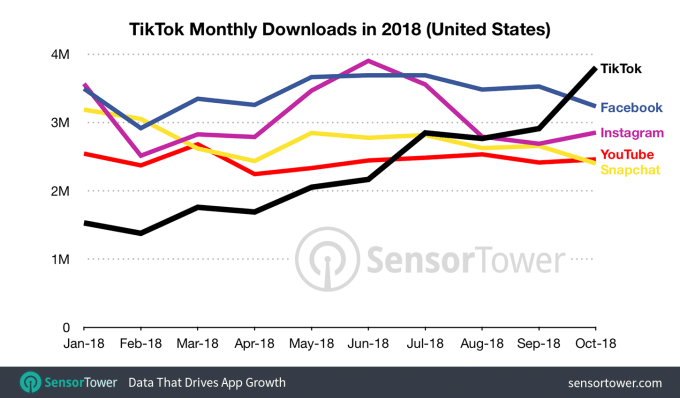
The launch of the video series comes at a time when TikTok’s growth is surging. The app recently surpassed a billion installs across the iOS App Store and Google Play, including Lite versions and regional variations, but excluding Android installs in China, according to data from Sensor Tower.
Roughly 25 percent of those installs are from India, the report said. And around 663 million of TikTok’s total installs occurred in 2018, which made the app the No. 4 most downloaded non-game for the year.
However, installs alone don’t tell the story of how many people actually use the app or how often. And a chunk of these could be the same user installing the app on multiple devices, or even bots used to push the app up the charts. In addition, parents often download the app their tween or teen is using for monitoring purposes, but don’t engage with the app or its content on a regular basis.
Below, is a compilation of all the new videos launching today:
Powered by WPeMatico